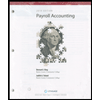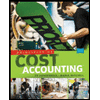
1.
Prepare a new contribution report for the month of April based on a flexible budget.
1.
Explanation of Solution
Flexible Budget: A flexible budget is a budget that is prepared for different levels of the output. In other words, it is a budget that adjusts according to the changes in the volume of the activity. The main purpose of preparing flexible budget is to determine the differences among standard and actual result.
Prepare a new contribution report for April based on a flexible budget as follows:
| Particulars | Flexible budget | Actual |
Variance |
| 450,000 Units (In pounds) (A) |
450,000 Units (In pounds) (B) | ||
| Revenue | $3,600,000 | $3,555,000 | $ 45,000 U |
| Less: Variable costs | |||
| Direct material | 652,500 | 865,000 | 212,500 U |
| Direct labor | 378,000 | 348,000 | 30,000 F |
| Variable | 729,000 | 750,000 | 21,000 U |
| Total variable costs | $1,759,500 | $1,963,000 | $203,500 U |
| Contribution margin | $1,840,500 | $1,592,000 | $248,500 U |
Table (1)
Working note (1):
Compute the flexible budget:
| Particulars | Static budget for 400,000 units (In Pounds) (a) | Flexible budget for 450,000 units (In Pounds) | |
| Revenue | $3,200,000 | 1.125 | $3,600,000 |
| Direct material | 580,000 | 1.125 | 652,500 |
| Direct labor | 336,000 | 1.125 | 378,000 |
| Variable overhead | 648,000 | 1.125 | 729,000 |
| Total variable costs | $1,564,000 | 1.125 | $1,759,500 |
Table (2)
2.
State the total contribution margin in the flexible budget column of the new report prepared under requirement (1).
2.
Explanation of Solution
The total contribution margin on the flexible budget is $1,840,500
3.
Describe the meaning of the total contribution margin in the flexible budget column of the new report prepared for the month of April.
3.
Explanation of Solution
In this case, the unit sales price and unit variable costs had all remained same at their budgeted levels, however the sales volume has been increased from 400,000 units to 450,000 units, as a result this would in turn increases the contribution margin to $1,840,500
4.
Ascertain the total variance between the flexible budget contribution margin and the actual contribution margin of the new report prepared from requirement (1) and calculate the following variances in order to explain this total contribution margin variance.
- a. Direct-material price variance.
- b. Direct-material quantity variance.
- c. Direct-labor rate variance.
- d. Direct-labor efficiency variance.
- e. Variable-overhead spending variance.
- f. Variable-overhead efficiency variance.
- g. Sales-price variance.
4.
Explanation of Solution
The variance between the flexible budget contribution margin and the actual contribution margin is $248,500 U.
Calculate the following variance to verify this $248,500 Unfavorable variance between the flexible budget and actual contribution margin (computed in requirement 1).
- a. Compute the direct material price variance:
| Type of Material | Actual quantity (a) | Actual price (2) –standard price (b) | Variance |
| Cookie mix | 4,650,000 | 0 | |
| Milk chocolate | 2,660,000 | 133,000 U | |
| Almonds | 480,000 | 0 | |
| Total | $133,000 U |
Table (3)
Working note (2):
Compute the actual price:
| Type of Material | Actual quantity (a) | Actual Cost (b) | Actual price |
| Cookie mix | 4,650,000 | $93,000 | 0.02 |
| Milk chocolate | 2,660,000 | 532,000 | 0.20 |
| Almonds | 480,000 | 240,000 | 0.50 |
Table (4)
- b. Compute the direct material quantity variance:
| Type of Material | Standard price (a) | Actual quantity–Standard quantity (3) (b) | Variance |
| Cookie mix | $0.2 | 0 | |
| Milk chocolate | $0.15 | 133,000 U | |
| Almonds | $0.50 | 0 | |
| Total | $133,000 U |
Table (5)
Working note (3):
Compute the standard quantity:
| Type of Material | Actual pounds produced (a) | Standard unit(b) | Standard quantity |
| Cookie mix | 10 Oz | 450,000 | 4,500,000 |
| Milk chocolate | 5Oz | 450,000 | 2,250,000 |
| Almonds | 1 Oz | 450,000 | 450,000 |
Table (5)
- c. Compute the direct labor rate variance:
The direct labor rate variance is zero. Because when dividing the total actual labor cost by the actual labor time used, for each type of labor, it shows that the actual rate and the standard rate are the same.
- d. Compute the direct labor efficiency variance:
| Type of Material | Standard rate per minute (a) | Actual hour–Standard hour (4) (b) | Variance |
| Mixing | $0.24 | 0 | |
| Baking | $0.30 | 133,000 U | |
| Total | $133,000 U |
Table (6)
Working note (3):
Compute the standard hour:
| Type of Material | Standard unit (a) | Standard minute per unit (b) | Standard hour |
| Mixing | 450,000 | 1 minute | 450,000 |
| Baking | 450,000 | 2 minute | 900,000 |
Table (7)
- e. Compute the variable overhead spending variance:
- f. Compute the variable overhead efficiency variance:
- g. Compute the sales price variance:
Total variance:
| Particulars | Amounts in ($) |
| Direct-material price variance | $133,000 U |
| Direct-material quantity variance | 79,500 U |
| Direct-labor rate variance | 0 |
| Direct-labor efficiency variance | 30,000 F |
| Variable-overhead spending variance | 75,000 U |
| Variable-overhead efficiency variance | 54,000 F |
| Sales-price variance | 45,000 U |
| Total | $248,500 U |
Table (8)
5. a
Describe the problems that the company might face when using direct-labor hours as the basis for applying Overhead.
5. a
Explanation of Solution
The company might face the problem of inappropriate cost driver when using direct-labor hours as the basis for applying Overhead. Because, direct-labor hours is the activity that may not drives variable overhead. Moreover, this could be experienced in the
5. b
Describe the manner in which the activity-based costing (ABC) would solve the problems described in requirement (5a).
5. b
Explanation of Solution
The company should consider activity-based costing (ABC) as an alternative. In this case, the direct labor does not seem to have a direct cause-and-effect relationship with variable overhead. Therefore the company should try to identify the activity or activities that drive variable overhead. The activity-based costing may not be beneficial if the same proportion of these activities is used in all the products of the company. Thus, the activity-based costing (ABC) could only be beneficial if the products require a different mix of these activities.
Want to see more full solutions like this?
Chapter 11 Solutions
Managerial Accounting: Creating Value in a Dynamic Business Environment
- The trial balance for K and J Nursery, Incorporated, listed the following account balances at December 31, 2024, the end of its fiscal year: cash, $27,000; accounts receivable, $22,000; inventory, $36,000; equipment (net), $91,000; accounts payable, $25,000; salaries payable, $10,500; interest payable, $6,500; notes payable (due in 18 months), $41,000; common stock, $72,000. Determine the year-end balance in retained earnings for K and J Nursery, Incorporated.arrow_forwardWhat would be the total production engineering cost per unitarrow_forwardI want the correct answer with accounting questionarrow_forward
- Accountingarrow_forwardBrun Company produces its product through two processing departments: Mixing and Baking. Information for the Mixing department follows. Direct Materials Conversion Unit Percent Complete Percent Complete Beginning work in process inventory 7.500 Units started this period 104,500 Units completed and transferred out 100.000 Ending work in process inventory 12.000 100% 25% Beginning work in process inventory Direct materials Conversion $6.800 14.500 $21.300 Costs added this period Drect materials 116,400 Conversion Total costs to account for 1.067,000 1.183.400 $1.204.700 Required 1. Prepare the Mixing department's production cost report for November using the weighted average method Check (1) C$1.000 2. Prepare the November 30 journal entry to transfer the cost of completed units from Mixing to Bakingarrow_forwardNonearrow_forward
 Cornerstones of Cost Management (Cornerstones Ser...AccountingISBN:9781305970663Author:Don R. Hansen, Maryanne M. MowenPublisher:Cengage Learning
Cornerstones of Cost Management (Cornerstones Ser...AccountingISBN:9781305970663Author:Don R. Hansen, Maryanne M. MowenPublisher:Cengage Learning
 Principles of Cost AccountingAccountingISBN:9781305087408Author:Edward J. Vanderbeck, Maria R. MitchellPublisher:Cengage Learning
Principles of Cost AccountingAccountingISBN:9781305087408Author:Edward J. Vanderbeck, Maria R. MitchellPublisher:Cengage Learning Managerial AccountingAccountingISBN:9781337912020Author:Carl Warren, Ph.d. Cma William B. TaylerPublisher:South-Western College Pub
Managerial AccountingAccountingISBN:9781337912020Author:Carl Warren, Ph.d. Cma William B. TaylerPublisher:South-Western College Pub Financial And Managerial AccountingAccountingISBN:9781337902663Author:WARREN, Carl S.Publisher:Cengage Learning,
Financial And Managerial AccountingAccountingISBN:9781337902663Author:WARREN, Carl S.Publisher:Cengage Learning,




